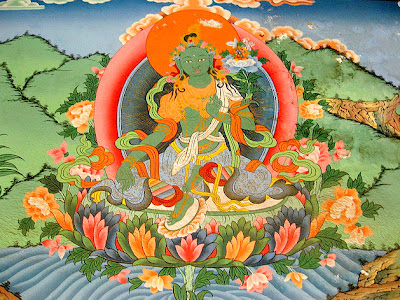Photo: www.keralatourism.org
Painting as an art dates back to pre-historic times and is common to humans spanning cultures across the globe. The history represents a continuous, though disrupted tradition from antique remains. Across cultures and straddling continents and millennia, the art of painting has remained an extant stream of creative thoughts. The earliest evidence of this art is the etchings and paintings found on the walls and ceilings of caves, where humans settled more than 30,000 years ago. Over time, as the globe split into independent countries, so became pronounced the efforts to protect and preserve own traditions and beliefs unique to this art.Today, despite the rampant commercialization of art, there still are some societies like India that actively encourage their artisans to cleave to the traditional forms. One such form receiving increasing attention and international accolades these days is Kerala's mural paintings, better known as Temple Paintings. They remained concealed within the sanctum sanctorum of some of the oldest temples and royal palaces in Kerala for centuries. Most of the temple paintings available in Kerala and neighboring states today, once commissioned by the royal families, were made not earlier than 1600 AD. But there is no specific record available about the conception of this style.
Looking at the intricacies of these temple paintings, there is little doubt that the artists must have studied the Hindu mythology and also temple sculptures in great depth. It seems that the artists had to exercise elaborate creativity, imagine the characters and run the scene in their minds before transforming the same on to the base.
 While these paintings bear similarities in portraiture of characters with the mural paintings of Tibet, China and Nepal, and may also allude to the cave art of Ajanta and Ellora, what makes the Kerala style of temple painting unique is that it centres on figurines, mostly the divine characters from the Hindu myths. There are some anecdotal versions and research studies connecting these temple paintings to the etchings in Wayanad caves in Kerala; but while the cave etchings are found to be thousands of years old, temple paintings probably do not date back so far.
While these paintings bear similarities in portraiture of characters with the mural paintings of Tibet, China and Nepal, and may also allude to the cave art of Ajanta and Ellora, what makes the Kerala style of temple painting unique is that it centres on figurines, mostly the divine characters from the Hindu myths. There are some anecdotal versions and research studies connecting these temple paintings to the etchings in Wayanad caves in Kerala; but while the cave etchings are found to be thousands of years old, temple paintings probably do not date back so far.The preparation and materials for making these paintings also add to the uniqueness of this art. The paintings are made on brick walls plastered with lime and sand. Charcoal is used for sketching the figures. The colors used include white, yellow, red, green and black, all of which, except the white base, are prepared from various stones, leaves and fruits. The brushes used to paint are made of locally available grass varieties. In nutshell, in accordance with the temple sanctity, only vegetarian varieties are used to make these godly paintings.
Looking at the intricacies, there is little doubt that the artists must have studied the Hindu mythology and also temple sculptures in great depth. It seems that the artists had to exercise elaborate creativity, imagine the characters and run the scene in their minds before transforming the same on to the base. Paintings of Lord Shiva in the Nataraja form, Lord Vishnu in the Ananthasayana posture, Brahma and Goddesses narrated in the dhyana shlokas, are not merely works of art, but also divine artistic representations, similar to the vigrahas.
Years back when Guruvayoor Devaswom Board decided to paint the newly built walls, they tried to locate artists who were skilled in this traditional art form. It was then that they realized that only a few artists of this great tradition remained. Fearing the loss of this rich heritage, the Board established a training centre under its wing with Mammiyoor Krishnankutty Nair as the founder trainer. At present, it runs under the stewardship of K U Krishnakumar. Today the prodigies of this more than twenty year old institution are traveling across the globe on commissioned works. The efforts of this institution in preserving and continuing the tradition is laudable. It will be their success if these artists do not commercialize this divine art-form.
Mural Paintings of Kerala
Courtesy: YouTube

